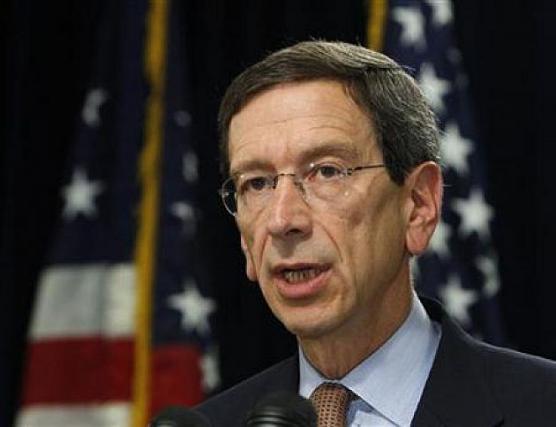Dear Iranian Negotiators,
Some of you may remember me from the time I served on the American delegation to the nuclear talks. Although I left the U.S. Government over a year ago, I try to follow the negotiations closely, and I have been impressed by the determination and professionalism that you – as well as the Americans and indeed all the parties – have brought to the table.
Although you have earned a respite from what has been a grueling negotiating schedule – an opportunity to catch up on your sleep and spend time with your families – I see that, with your recent meeting with the Americans in Geneva, your “vacation” has been a short one. I think it is an indication of the seriousness with which Tehran and Washington are approaching the negotiations. Now you will be conferring intensively with your colleagues in Tehran, taking stock, and planning next steps.
Your decision to extend the talks until November 24 was the right choice. You and the other parties all wanted to complete a comprehensive solution by July 20. That proved impossible. But given the significant progress that has been made on such major issues as the Arak reactor and the Fordow facility, it would have been a lost opportunity – indeed a potentially historic mistake – to halt the process in July.
You know better than I that your work is cut out for you between now and November 24. You face many technically complex and politically fraught issues. Even if you had reached agreements in principle on all the hard issues in July, it would have been a major challenge to hammer out all the crucial details before the expiration of the extension. But a substantial number of very hard issues remained unresolved when the July deadline arrived, even in areas where significant progress had been made.
Perhaps the hardest of the issues – the one where the gap between Iran and the P5+1 countries is greatest – is the uranium enrichment capacity Iran would possess under the Comprehensive Joint Plan of Action (CJPOA). In my view, it is the “make or break” issue in the negotiations. If it can be resolved, I believe agreements on all other issues will be reached, although not without difficulty. But failure to come to terms on enrichment capacity will mean the failure of the negotiations.
The current divide is huge. Iran says it needs to have an industrial-scale enrichment program to produce fuel for the Bushehr power reactor – and to have such a capability in place and operating by the time the Iran-Russia fuel supply contract expires in 2021. The P5+1 countries call for reducing Iran’s current enrichment capacity to a few thousand first-generation centrifuges, argue that such a capability would be sufficient to meet Iran’s need to produce fuel for a few research reactors, and believe that Iran’s need to fuel the Bushehr power reactor can be met reliably and economically by extending the fuel supply contract with the Russians.
I’m sure that, to an Iranian audience, the case for acquiring an independent fuel production capability for power reactors at the earliest possible date must sound persuasive. Iran has invested much time and resources in its nuclear program, is understandably proud of the achievements of its scientists, and believes it is entitled as an NPT member to see the program advance in a manner and at a pace of its own choosing. Given Iran’s perception that the West has tried to exploit Iranian reliance on strategically important imports for political purposes, including Iran’s disappointing experience with the Eurodif uranium enrichment consortium, Tehran is also wary of becoming overly dependent on foreign suppliers of enriched uranium. And of course, there is an important political and even emotional dimension of Iran’s position. Having struggled to reach the present stage of their nuclear program in defiance of international efforts to stifle it, Iranians view the program as a symbol of national pride, perseverance, and independence and are acutely sensitive to what they perceive as foreign attempts to hold it back.
But to an audience in the United States and other P5+1 countries, the argument for a near-term, industrial-scale enrichment capability is unconvincing, even suspicious. To that audience, Iran’s insistence on an early and major ramping up of its enrichment capacity doesn’t make sense from the standpoint of a well-conceived civil nuclear program. They ask why Iran is not willing to meet Bushehr’s fuel needs by simply extending its fuel supply contract with Russia:
when receiving the fuel from Russia is, at least for the time being, the more economical and safer choice;
when fabricating highly specialized Bushehr fuel in such a short time period would be a huge technical challenge, especially without Russian assistance; and
when the P5+1 are willing to go to great lengths to provide guarantees against a supply disruption, including by stockpiling several years’ worth of spare fuel in Iran.
They also ask why Iran is refusing to reduce its current enrichment capacity during the CJPOA:
when only a very limited capacity is required to meet Iran’s practical, near-term need to fuel a few research reactors; and
when Iranian nuclear experts recognize that currently installed generations of centrifuges have no place in an advanced civil program and will have to be phased out before long in any event.
Some observers in P5+1 countries offer relatively benign explanations for Iran’s seemingly illogical civil nuclear plans. They suggest that the West underestimates Iran’s genuine fear of dependence on foreign suppliers, that Iran’s nuclear experts truly believe they can overcome the technical and other obstacles to producing Bushehr power reactor fuel by 2021, and that the Rouhani Administration is under strong pressure from its domestic critics not to accept P5+1 proposals even when those proposals are consistent with the requirements of a rational Iranian civil nuclear program.
But other observers have a less benign explanation. They believe Iran is refusing to reduce its current enrichment capacity and insisting on the freedom to expand that capacity dramatically by 2021 in order to protect the option to produce enough weapons-grade uranium for a nuclear weapon in a matter of a few weeks.
Understandably, Iran would like the international community to take its declarations of peaceful intent at face value, to regard the task of gaining confidence in Iran’s peaceful intent as similar to the task of confirming the peaceful intent of any other NPT party, and to look only forward and not backward in assessing the requirements of a comprehensive solution.
But the circumstances surrounding the Iran nuclear issue make it impossible for the P5+1 and the wider international community to proceed along those lines. As you well know, the United States and many other countries believe that, at least until 2003 and perhaps beyond, Iran actively and systematically engaged in research, experimentation, and procurement related to the development of nuclear weapons. Moreover, they believe Iran has kept open the option to pursue nuclear weapons, even if – as the U.S. intelligence community continues to judge – no decision has been made in Tehran to exercise that option.
I know that you vigorously and categorically reject these assessments and don’t want them to serve as a justification for the special constraints and monitoring measures the P5+1 insist must be included in a comprehensive solution. I also know that many in Iran believe that the United States is not genuinely concerned about Iran’s nuclear program but has manufactured an “Iranian nuclear weapons threat” as a pretext to put economic and political pressure on a strong and independent Iran that Washington sees as an impediment to its regional and strategic interests. But these Iranian views about the U.S. assessment of Iran’s nuclear program and about the U.S. motivation for focusing so heavily on it are wrong. From the U.S. perspective, concerns about Iran’s nuclear intentions are genuine, strong, and well-founded, and those concerns form the fundamental backdrop of the negotiations and will take considerable time to allay.
Frankly, I don’t know if Iran harbors an interest – personally, I would say still harbors an interest – in acquiring nuclear weapons. But I do know that, unless Iran is prepared to accept the kind of negotiated measures that can provide confidence that its nuclear program is and will remain exclusively peaceful, there will be no agreement.
Senior Iranian officials have repeatedly said that Iran has a strong interest in removing ambiguities and alleviating international concerns – however unjustified, they often add. But Iranian insistence on operating an industrial-scale enrichment program by 2021 – which ensures a “breakout” capability of only a few weeks – does not alleviate concerns. It sharply heightens them.
Iranian spokespersons have tried to make the argument that the peaceful intent of Iran’s nuclear program is “proven” by publicly announcing that its planned industrial-scale enrichment program will be used to fuel electricity-producing power reactors. It should not be surprising to you that this argument is, to say the very least, unpersuasive.
Now is the time for the parties in the talks to make hard decisions on resolving the enrichment capacity issue. If they return to the negotiating table in September with the same positions they held in July – with the hope that the other side will give in at the 11th hour – there is a strong possibility that those positions will become further entrenched and the parties will find themselves, as November 24 approaches, facing the difficult choice between ending the negotiating process or extending it again and becoming the target of powerful domestic criticism for allowing the talks to continue indefinitely.
But with the two sides having publicly staked out relatively specific and diametrically opposed positions – based on very different conceptions of the practical needs of Iran’s civil nuclear program – finding common ground will not be easy.
To reconcile these seemingly contradictory approaches, it may be useful to focus on the variable of time – with the P5+1 countries realizing their goals in the nearer term and Iran achieving the freedom, and the technical capability, to realize its declared goals in the longer term. An approach along these lines might include the following basic features. I offer it, for your consideration, as my personal assessment of what might bridge the interests of the two sides, although naturally you will be the judge of what best serves Iran’s interests.
During the duration of the Comprehensive Joint Plan of Action, Iran’s enrichment capacity would be limited to a few thousand first-generation centrifuges or a smaller number of second-generation IR-2ms, a capacity sufficient to meet the fuel requirements of its planned research reactors. Depending on the evolving fuel requirements of Iran’s research reactor program as well as Iran’s record in implementing the CJPOA and cooperating with the IAEA (including with its investigation of the possible military dimensions of Iran’s nuclear program), that limit might be raised in the latter part of the CJPOA if the duration is sufficiently long.
During the CJPOA, Iran would be permitted to engage in various civil nuclear activities that would enable it to realize important benefits in the short run while preparing it to move in a technically sound and expeditious manner in the longer run to the kind of advanced capability that it has described as its goal. Some of those activities would involve cooperation with P5+1 and other countries. For example, Iran and other countries could cooperate in the modification of the Arak reactor; the design, construction, and fueling of the small, light-water research reactor Iran intends to build; and perhaps also in planning the eventual construction of an indigenously-designed Iranian power reactor. Subject to agreed limits and special monitoring arrangements, Iran would be allowed to engage in research, development, and testing of advanced centrifuges. In addition, with the support of Russia, Iranian experts could be trained in the design and fabrication of Bushehr-type fuel, perhaps jointly producing the fuel in Russia and eventually moving production to Iran.
With the expiration of the CJPOA, Iran would be free – if it continues to see benefit in producing enriched uranium for power reactors – to ramp up its enrichment capacity, including by mass producing, installing, and operating advanced centrifuges that had been developed and tested while the CJPOA was in effect. While some of the measures that applied during the CJPOA would remain after its expiration (e.g., the ban on reprocessing, adherence to the Additional Protocol, special monitoring of centrifuge production), Iran would essentially be entitled to pursue its civil nuclear plans in a manner and at a pace that it considered warranted.
Within this suggested framework for addressing the enrichment capacity issue, critical details would, of course, have to be worked out. The most critical would be duration of the CJPOA. To promote confidence that Iran’s nuclear program is and will remain peaceful, I believe it would be important to agree on a period of around 15 years. But I recognize that the willingness of the Iranians to accept such a duration would depend significantly on the activities they would be permitted to carry out during the CJPOA, and particularly whether they regarded those activities as valuable means of advancing their program and preparing for the post-expiration period.
Essentially, this framework would call on Iran to defer but not abandon its stated civil nuclear goals. Surely there would be some opposition within Iran to such a delay. But much can be said in its favor.
It provides a more realistic timeframe for pursuing Iran’s declared plans. It is extremely doubtful that Iran would be able independently to produce fuel for Bushehr by 2021. The current plan assumes extraordinarily rapid success in developing, testing, mass producing, and installing advanced centrifuges. It also assumes that, without Russian assistance and over Russian objections, Iranians can design and fabricate safe and technically sound fuel for Bushehr. Both assumptions are unrealistic. By taking more time, Iran can be much more confident that it will have the technical skills to realize whatever civil nuclear goals it wishes to achieve.
The suggested framework does not in any way impede Iran’s ability to meet its nuclear research, isotope production, or electricity-generation requirements – the key goals of any civil nuclear program. Even with a significantly reduced enrichment capacity during the CJPOA, Iran will be able to produce enough enriched uranium to meet the needs of the research reactors it plans to build and operate in that timeframe. Moreover, by extending the Bushehr fuel-supply contract with Russia and developing special arrangements to guard against the (very remote) possibility of supply disruptions, Iran can ensure that its electricity-generation needs can be fulfilled reliably, safely, and economically.
(As an aside, Iranians should not regard reliance on foreign fuel supply for an additional period of time as an indication of second-class nuclear energy status. Japan has relied on foreign supplies for most of the enriched uranium it uses to fuel its power reactors. South Korea, with one of the world’s largest nuclear power programs, relies exclusively on foreign supplies. Perhaps more surprising to you, for close to two decades, the United States met half of its reactor fuel needs by importing enriched uranium from dismantled Soviet nuclear weapons and today – with the closure of its large gaseous diffusion enrichment plant and the operation in New Mexico of a URENCO enrichment plant that denies the United States access to its technology – no enriched uranium to fuel U.S. power reactors is being produced using U.S. technology.)
Another significant benefit of the suggested framework is that it could facilitate nuclear cooperation with the P5+1 and other countries in a wide range of areas. While justifiably proud of what Iranian scientists have managed to accomplish largely in isolation, Iranians would have much to gain from international nuclear cooperation, which is the norm in today’s highly integrated worldwide nuclear industry. So while the approach outlined here could somewhat lengthen Iran’s preferred timeframe for reaching its goals, any delay would be more than offset by the major advances that could be made through cooperation.
I know these arguments will not fully satisfy Iranian critics. They can be expected to claim that the framework suggested here requires Iran to make much greater concessions than the P5+1 countries. But that claim would be wrong. It ignores the major concessions the United States and its partners have already made (including on enrichment, sanctions, and Arak and Fordow), the additional concessions required under this framework (such as permitting advanced centrifuge R&D), as well as compromises that will be needed on a host of other CJPOA issues to conclude a deal – all of which will be strongly attacked by American critics who, in a mirror image of their Iranian counterparts, will argue that the United States got the worst of the deal.
The Iranian critics’ expected claim also ignores the fundamental benefit that Iran can derive from a nuclear deal – the opportunity to get its economy back on track and to enable the people of Iran to enjoy a more normal and prosperous life.
Of course, Iranians are a resourceful and resilient people and, if necessary, can “muddle through” without an agreement, coping with continued and even intensified pressures as best they can. But the Iranian people deserve better than muddling through, and I assume they understand that, until the confrontation over their nuclear program is resolved, the nuclear issue will remain an anchor dragging Iran down and preventing it from realizing its potential.
The United States and its partners know by now not to underestimate the strength of Iran’s national will to resist pressure and protect what it considers to be its rights and its interests. But Iranians should not underestimate U.S. determination that any agreement must meet the high standards necessary to provide confidence that Iran’s nuclear program is exclusively peaceful.
It is clear to me that both Iran and the United States want a deal but equally clear that neither wants a deal at any price. Both, I think, would be prepared to walk away from the negotiating table rather than accept an agreement they regarded as inconsistent with their basic requirements. Unfortunately, given the formidable obstacles you and the other negotiators face between now and November 24, such a result must be considered a real possibility. But I know that, before resigning yourselves to such an outcome – and the unpalatable options that would follow – you and your counterparts in the P5+1 and EU delegations will spare no effort to find a solution that all the parties can genuinely regard as a success.
From experience, I have learned not to use a term like “last opportunity.” But I do believe this may be the best opportunity for quite some time to resolve the nuclear issue and perhaps establish a more promising basis to tackle the difficult problems that have divided Iran and the United States for so long. If this opportunity is missed, much time may pass and things may get a lot worse before another opportunity comes around.
I wish you and all the other participants in the talks the best of luck in the weeks and months ahead.
Yours truly,
Bob Einhorn
The Brookings Institution
















